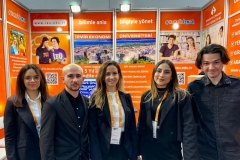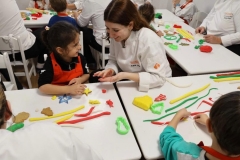
SCHOOL OF APPLIED MANAGEMENT SCIENCES
Gastronomy and Culinary Arts Program
GEIN 310 | Course Introduction and Application Information
| Course Name |
Innovation in Technology
|
|
Code
|
Semester
|
Theory
(hour/week) |
Application/Lab
(hour/week) |
Local Credits
|
ECTS
|
|
GEIN 310
|
Fall/Spring
|
3
|
0
|
3
|
5
|
| Prerequisites |
None
|
|||||
| Course Language |
English
|
|||||
| Course Type |
Service Course
|
|||||
| Course Level |
First Cycle
|
|||||
| Mode of Delivery | - | |||||
| Teaching Methods and Techniques of the Course | - | |||||
| Course Coordinator | ||||||
| Course Lecturer(s) | ||||||
| Assistant(s) | - | |||||
| Course Objectives | At the end of the course students will have knowledge about; concepts about innovation and technology, innovation process, product development, the steps to transfer different technologies to commercial area. |
| Learning Outcomes |
The students who succeeded in this course;
|
| Course Description | Provide information on innovation and technology, innovation process, analyzing successful innovations, types of innovation, product development, translation of innovation and effective presentation |
|
|
Core Courses | |
| Major Area Courses | ||
| Supportive Courses | ||
| Media and Management Skills Courses | ||
| Transferable Skill Courses |
WEEKLY SUBJECTS AND RELATED PREPARATION STUDIES
| Week | Subjects | Related Preparation |
| 1 | Introduction to innovation and technology | |
| 2 | Innovation Process, developing creative ideas, creative problem techniques | Shane, Scott. ‘Handbook of Technology and Innovation Management’, 2008, John Wiley and Sons Inc, West Sussex,England Part II Jan Fagerberg, David C. Mowery, and Richard R. Nelson, 2005, The Oxford Handbook of Innovation, Oxford University Press Chapter 4 |
| 3 | The Evolution of Technology, Markets, and Industry | Shane, Scott. ‘Handbook of Technology and Innovation Management’, 2008, John Wiley and Sons Inc,West Sussex,England Chapter 1 |
| 4 | The Development and Introduction of New Products | Shane, Scott. ‘Handbook of Technology and Innovation Management’, 2008, John Wiley and Sons Inc, West Sussex,England Part II |
| 5 | Market research (primary, secondary) and potential customer research | Shane, Scott. ‘Handbook of Technology and Innovation Management’, 2008, John Wiley and Sons Inc, West Sussex,England Part II Mullins, John, 2008, “The New Business Road Test”, Pearson Education Ltd. , Harlow Part 1 |
| 6 | The Management and Organization of Innovation | Shane, Scott. ‘Handbook of Technology and Innovation Management’, 2008, John Wiley and Sons Inc, West Sussex,England Part III Jan Fagerberg, David C. Mowery, and Richard R. Nelson, 2005, The Oxford Handbook of Innovation, Oxford University Press Chapter 5 |
| 7 | Innovation and entrepreneurship, Business model concept, analyzing and application of different business models | Shane, Scott. ‘Handbook of Technology and Innovation Management’, 2008, John Wiley and Sons Inc, West Sussex,England Part IV Alex Osterwalder, 2010, “Business Model Generations”, John Wiley and Sons Inc., New Jersey Chapter 1 |
| 8 | Business models, elevator pitch, action planning | Alex Osterwalder, 2010, “Business Model Generations”, John Wiley and Sons Inc., New Jersey Chapter 1 |
| 9 | Innovation and Intellectual Property | Shane, Scott. ‘Handbook of Technology and Innovation Management’, 2008, John Wiley and Sons Inc, West Sussex,England Chapter 10 Jan Fagerberg, David C. Mowery, and Richard R. Nelson, 2005, The Oxford Handbook of Innovation, Oxford University Press Chapter 10 |
| 10 | Finance and Innovation | Shane, Scott,‘Handbook of Technology and Innovation Management’, 2008, John Wiley and Sons Inc,West Sussex,England PartV Jan Fagerberg, David C. Mowery, and Richard R. Nelson, 2005, The Oxford Handbook of Innovation, Oxford University Press Chapter 9 |
| 11 | Individual Collaborations, Strategic Alliances, Competition and Innovation | Mullins, John, 2008, “The New Business Road Test”, Pearson Education Ltd. , Harlow Part 1 Shane, Scott,‘Handbook of Technology and Innovation Management’, 2008, John Wiley and Sons Inc,West Sussex,England Part IV |
| 12 | Effective presentation techniques | |
| 13 | Presentations | |
| 14 | Presentations | |
| 15 | Review | |
| 16 | Review |
| Course Notes/Textbooks | |
| Suggested Readings/Materials | Kawasaki, Guy, 2004, “ The Art of the Start “, Penguin Group, USA Richards, Doug, 2013, “How to Start A Creative Business”, David&Charles Alex Osterwalder, 2010, “Business Model Generations”, John Wiley and Sons Inc., New Jersey Mullins, John, 2008, “The New Business Road Test”, Pearson Education Ltd. , Harlow Shane, Scott. ‘Handbook of Technology and Innovation Management’, 2008, John Wiley and Sons Inc, West Sussex,England Jan Fagerberg, David C. Mowery, and Richard R. Nelson, 2005, The Oxford Handbook of Innovation, Oxford University Press |
EVALUATION SYSTEM
| Semester Activities | Number | Weigthing |
| Participation | ||
| Laboratory / Application | ||
| Field Work | ||
| Quizzes / Studio Critiques | ||
| Portfolio | ||
| Homework / Assignments |
1
|
20
|
| Presentation / Jury |
1
|
30
|
| Project |
1
|
30
|
| Seminar / Workshop |
1
|
20
|
| Oral Exams | ||
| Midterm | ||
| Final Exam | ||
| Total |
| Weighting of Semester Activities on the Final Grade |
4
|
100
|
| Weighting of End-of-Semester Activities on the Final Grade | ||
| Total |
ECTS / WORKLOAD TABLE
| Semester Activities | Number | Duration (Hours) | Workload |
|---|---|---|---|
| Theoretical Course Hours (Including exam week: 16 x total hours) |
16
|
3
|
48
|
| Laboratory / Application Hours (Including exam week: '.16.' x total hours) |
16
|
0
|
|
| Study Hours Out of Class |
1
|
20
|
20
|
| Field Work |
0
|
||
| Quizzes / Studio Critiques |
0
|
||
| Portfolio |
0
|
||
| Homework / Assignments |
1
|
22
|
22
|
| Presentation / Jury |
1
|
30
|
30
|
| Project |
1
|
30
|
30
|
| Seminar / Workshop |
0
|
||
| Oral Exam |
0
|
||
| Midterms |
0
|
||
| Final Exam |
0
|
||
| Total |
150
|
COURSE LEARNING OUTCOMES AND PROGRAM QUALIFICATIONS RELATIONSHIP
|
#
|
Program Competencies/Outcomes |
* Contribution Level
|
||||
|
1
|
2
|
3
|
4
|
5
|
||
| 1 | Successfully applies theoretical and practical knowledge and skills in Gastronomy and Culinary Arts |
|||||
| 2 | Carries best practices in terms of work and food security, safety and hygiene in food production |
|||||
| 3 | Appreciates, evaluates and makes decisions regarding to visual, textual and nutritional data with respect to food production and presentation |
|||||
| 4 | Recognizes and evaluates the impact of gastronomy on culture and society |
|||||
| 5 | Assumes responsibility for solving complex problems that may occur in the field of Gastronomy and Culinary Arts, both individually and as a team member |
|||||
| 6 | Evaluates the knowledge and skills acquired in the field of Gastronomy and Culinary Arts with a critical approach and effectively communicate their ideas and suggestions for solutions in written and oral form. |
|||||
| 7 | Possesses necessary knowledge and skills in relevant fields such as gastronomy, design, law and management and effectively apply them to the practice of Culinary Arts |
|||||
| 8 | Uses the technological tools related to Gastronomy and Culinary Arts effectively |
|||||
| 9 | Updates and improve the knowledge, skills and competencies related to Gastronomy and Culinary Arts with lifelong learning awareness and sustainability with an ethical approach |
|||||
| 10 | Collects data in the areas of Gastronomy and Culinary Arts and communicate with colleagues in a foreign language. (European Language Portfolio Global Scale”, Level B1) |
|||||
| 11 | Speaks a second foreign at a medium level of fluency efficiently |
|||||
| 12 | Relates the knowledge gained through the history of humanity to the field of expertise |
|||||
*1 Lowest, 2 Low, 3 Average, 4 High, 5 Highest
NEWS |ALL NEWS
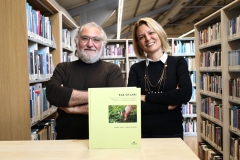
Award-Winning Book Receives Great Interest
The book ‘Ege Otları (Aegean Herbs)’ authored by Asst. Prof. Dr. Betül Öztürk from Department of Gastronomy and Culinary Arts, Izmir University

Appointment ceremony for 104 academics
A special ceremony was held at Izmir University of Economics (IUE) for the 104 academics appointed to professorship, associate professorship, and assistant

Aegean flavors from the chefs of the future
Izmir University of Economics (IUE) Department of Gastronomy and Culinary Arts left its mark on the 6th Izmir GastroFest, organized this year with
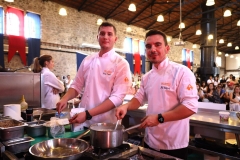
They added flavor to GURMEFEST
GURMEFEST, one of the biggest food, drink and entertainment festivals of Izmir, was ‘flavored’ with the dishes prepared and presented by the
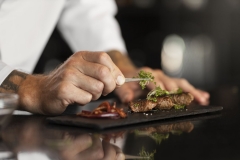
“Izmir and Bodrum will class up”
The MICHELIN Guide, one of the most prestigious restaurant rating systems in the world, has added Izmir and Bodrum to its Turkish
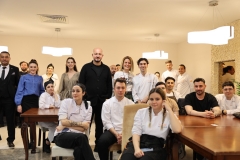
IUE graduates will prepare the flavors unique to Turkish cuisine
Bilsev Group, who is preparing to expand to Dubai this year with its Ferdi Baba, Fabrice Restaurant and Baba Pizza brands, will



